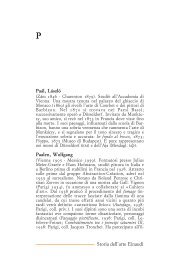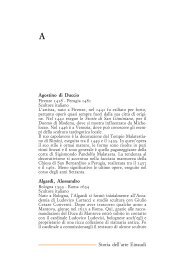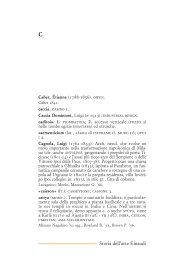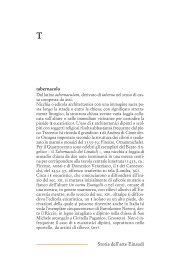Create successful ePaper yourself
Turn your PDF publications into a flip-book with our unique Google optimized e-Paper software.
10 w. schmid - o. stählin, Geschichte der griechischen L<strong>it</strong>eratur c<strong>it</strong>.,<br />
I, i, p. 157.<br />
11 Cfr. herman reich, Der Mimus, I, 1903, p. 547.<br />
12 e. a. gardner, Early Athens, in The Cambridge Ancient History,<br />
III, 1929, p. 585.<br />
13 g. thomson, nell’esporre questa teoria (Aeschylus and Athens c<strong>it</strong>.,<br />
p. 45), si richiama a v. grönbeck, Culture of the Teutons, 1931.<br />
14 h. m. chadwick, The Heroic Age c<strong>it</strong>., p. 228.<br />
15 Ibid., p. 234.<br />
16 a. r. burn, Minoans, Philistines and Greeks, 1930, p. 200.<br />
17 paul cauer, Grundfragen der Homerkr<strong>it</strong>ik, 1909, 2 a ed., pp.<br />
420-23.<br />
18 schmid-stählin, Geschichte der griechischen L<strong>it</strong>eratur c<strong>it</strong>., I, 1,<br />
pp. 79-81.<br />
19 u. von wilamow<strong>it</strong>z - möllendorff, Die griechische L<strong>it</strong>eratur des<br />
Altertums, 1912, 3 a ed., p. 17.<br />
20 bernhard schwe<strong>it</strong>zer, Untersuchungen zur Chronologie und<br />
Geschichte der geometrischen Stile in Griechenland, «Athen. M<strong>it</strong>teilungen»,<br />
XLIII, 1918, p. 112.<br />
21 Cfr. w. jäger, Paideia. Die Formung des griechischen Menschen,<br />
1934, p. 249 [trad. <strong>it</strong>., Paideia, Firenze 1953].<br />
22 u. von wilamow<strong>it</strong>z - möllendorff, Einle<strong>it</strong>ung in die griechische<br />
Tragödie, 1921, p. 105.<br />
23 Cfr. edgar zilsel, Die Entstehung des Geniebegriffs, 1926, p. 19.<br />
24 jakob burckhardt, Griechische Kulturgeschichte, IV, 1902, p. 115.<br />
25 ludwig curtius pensa che <strong>da</strong>l vi secolo in poi «ogni importante<br />
scultura greca portava sul basamento l’epigrafe che, oltre al nome<br />
del donatore e a quello del dio a cui l’opera era dedicata,... conteneva<br />
di regola il nome o i nomi degli artisti» (Die Antike Kunst, 1938, II, 1,<br />
p. 246).<br />
26 w. jäger, Paideia ecc. c<strong>it</strong>., p. 301; cfr. c. m. bowra, Sociological<br />
Remarks on Greek Poetry, «Ze<strong>it</strong>schrift für Sozialforschung», VI,<br />
1937, p. 393.<br />
27 b. schwe<strong>it</strong>zer, Der bildende Künstler und der Begriff des Künstlerischen<br />
in der Antike, 1925, p. 45.<br />
28 t. b. l. webster, Greek Art and l<strong>it</strong>erature 530-4oo B. C., 1939,<br />
vuole scorgere nel sensualismo la speciale tendenza stilistica della corte<br />
di Policrate, nell’intellettualismo quella della corte di Pisistrato.<br />
29 Periegesis, V, 21.<br />
30 j. d. beazley, Early Greek Art, in Cambridge Ancient History, IV,<br />
1926, p. 589.<br />
31 g. thomson, Aeschylus and Athens c<strong>it</strong>., p. 353.<br />
32 gilbert murray, A History of Ancient Greek L<strong>it</strong>erature, 1937,<br />
p. 279.<br />
Arnold Hauser <strong>Storia</strong> <strong>sociale</strong> dell’arte<br />
<strong>Storia</strong> dell’arte Einaudi 116















